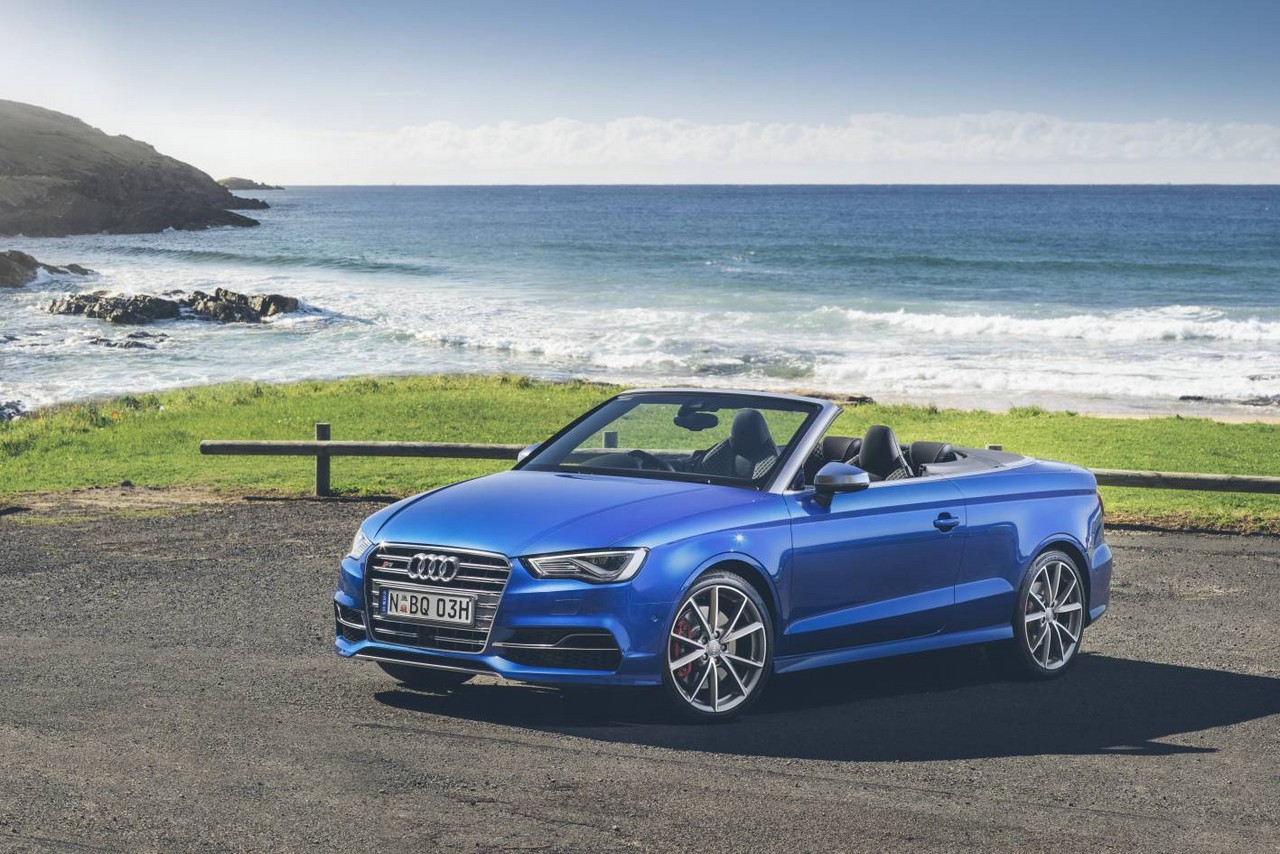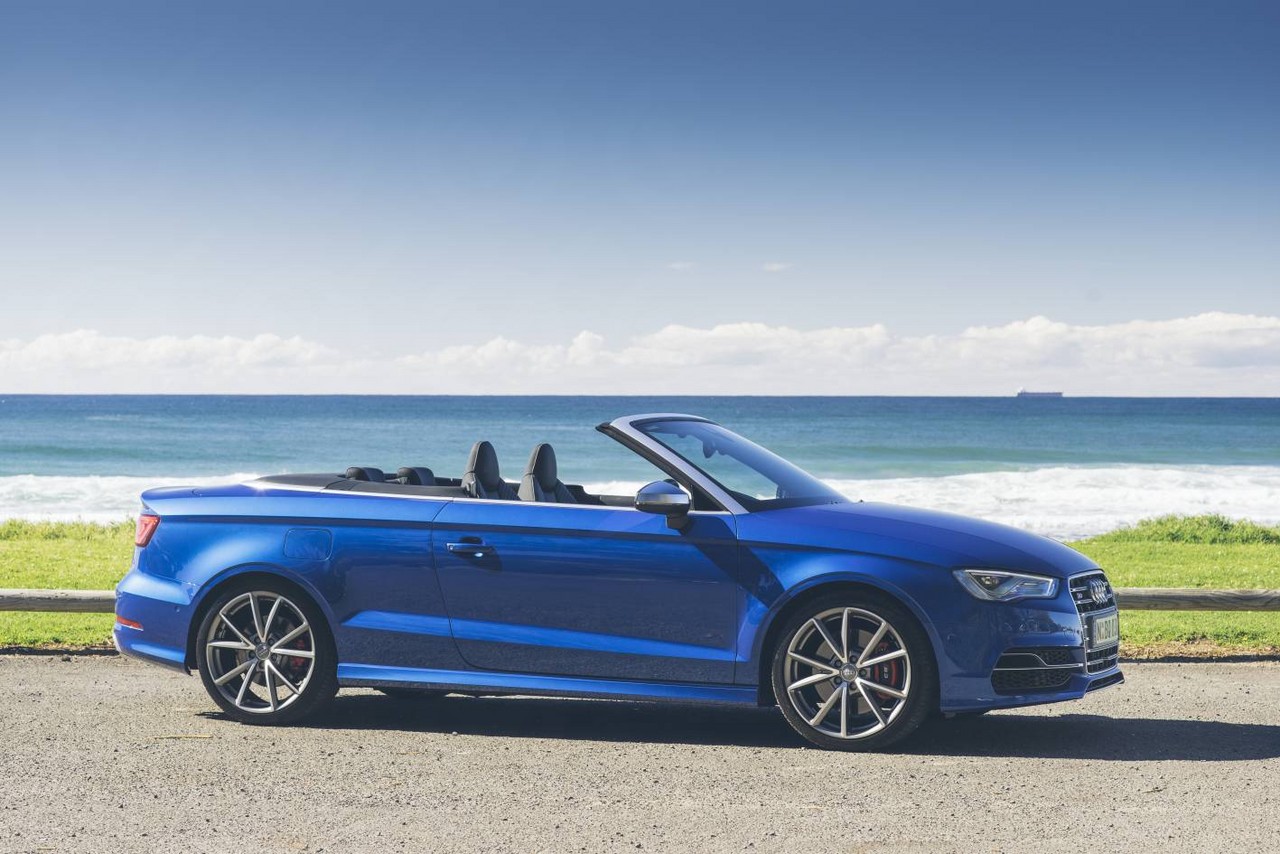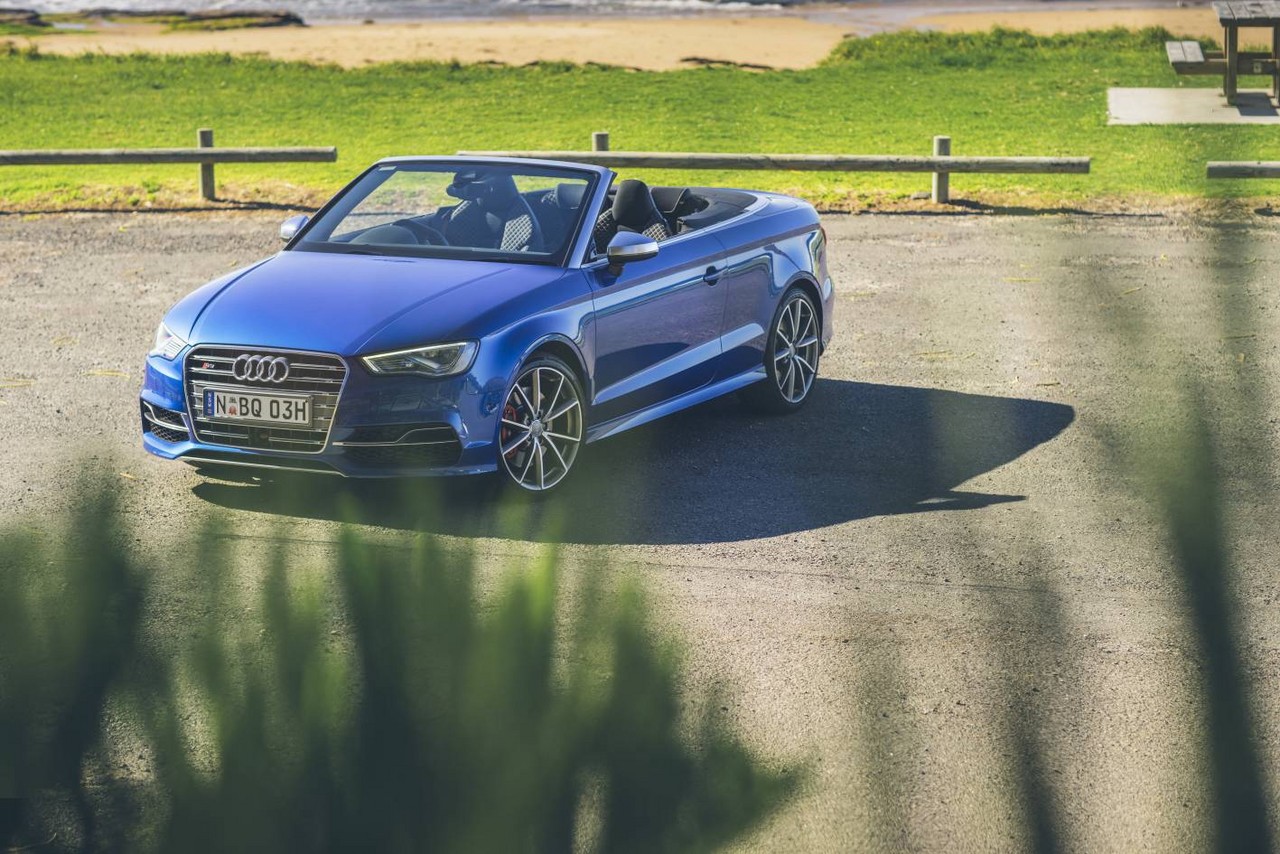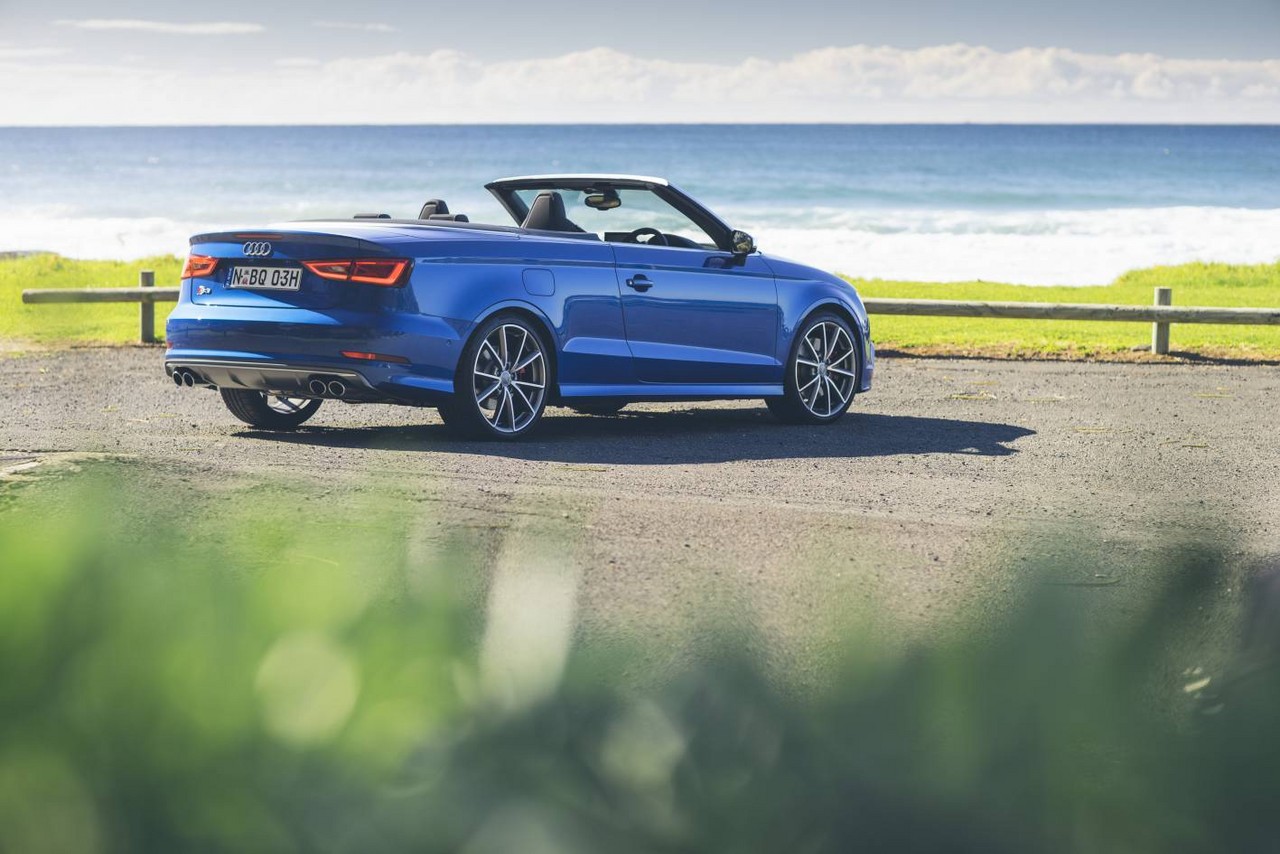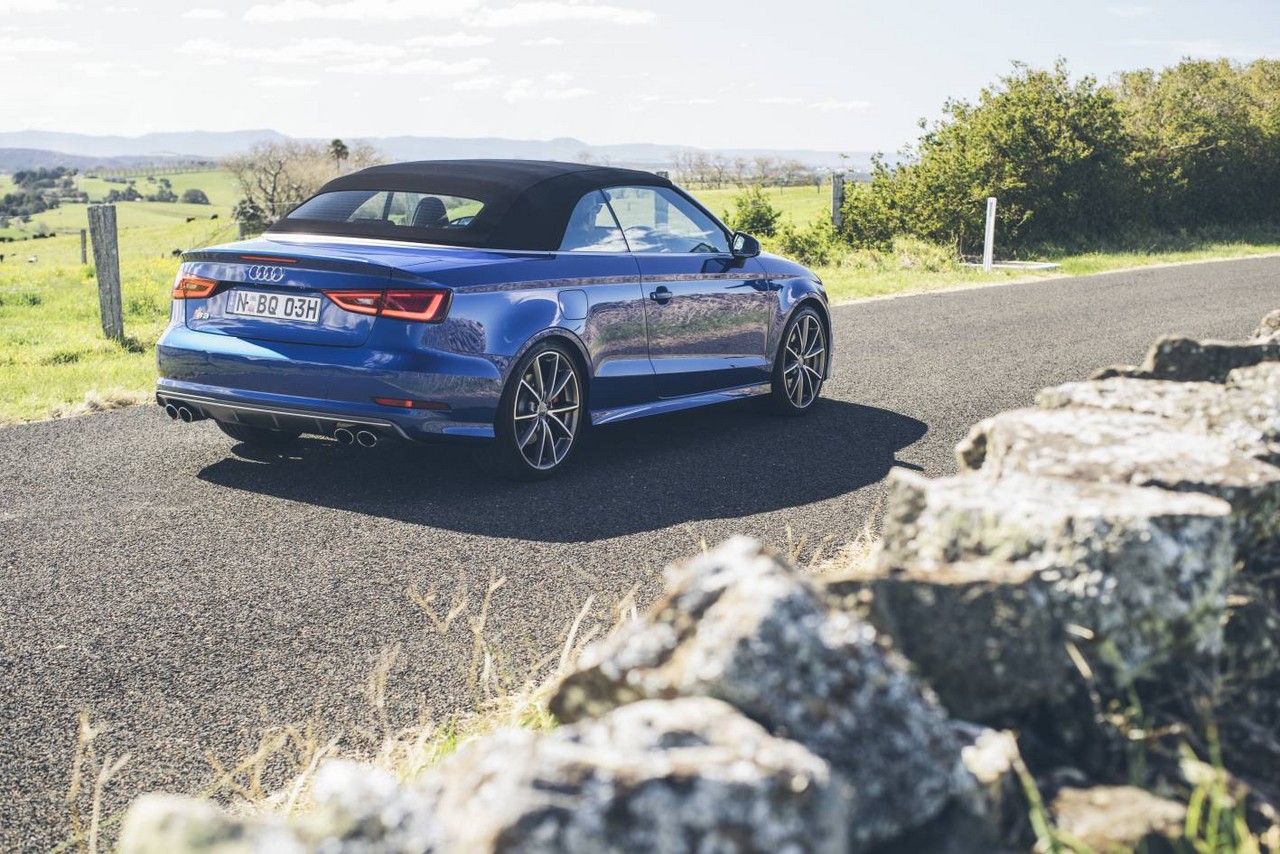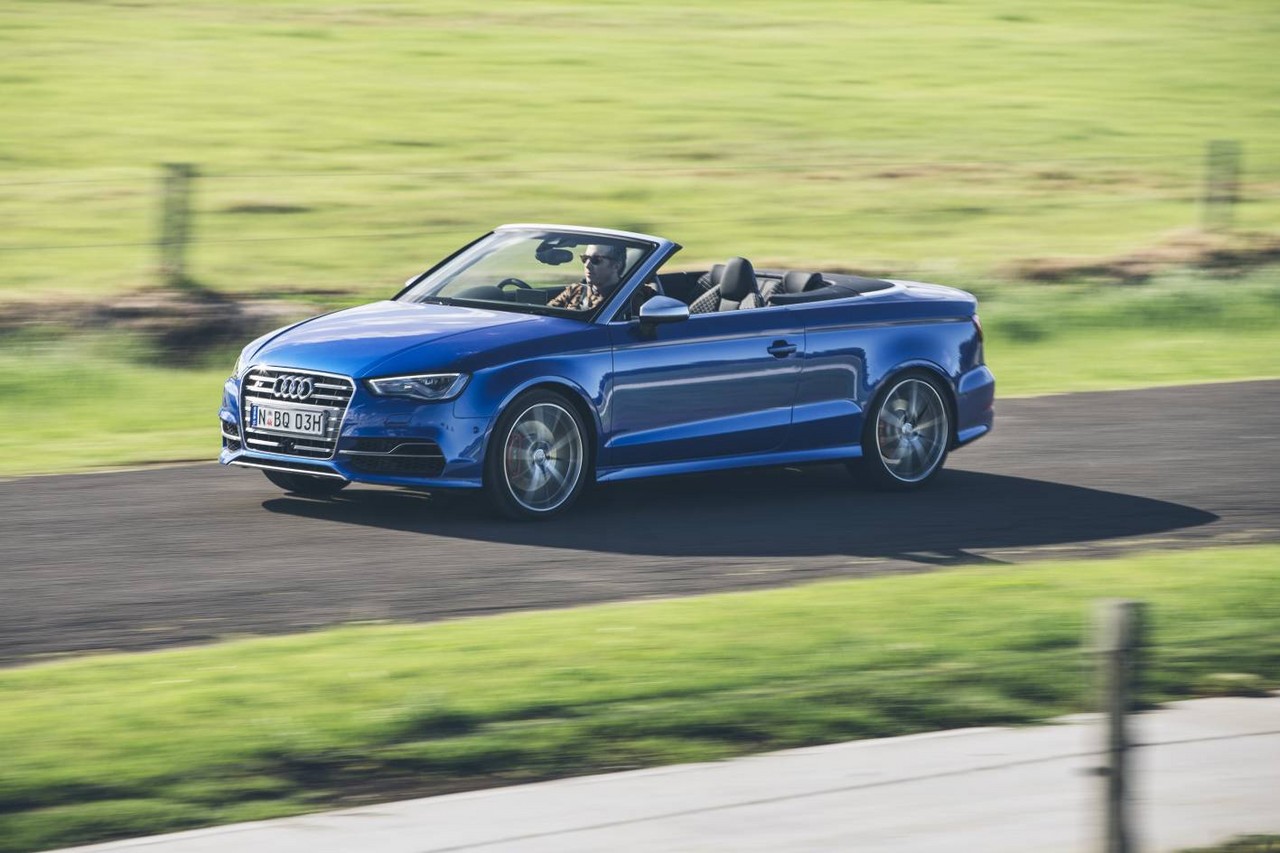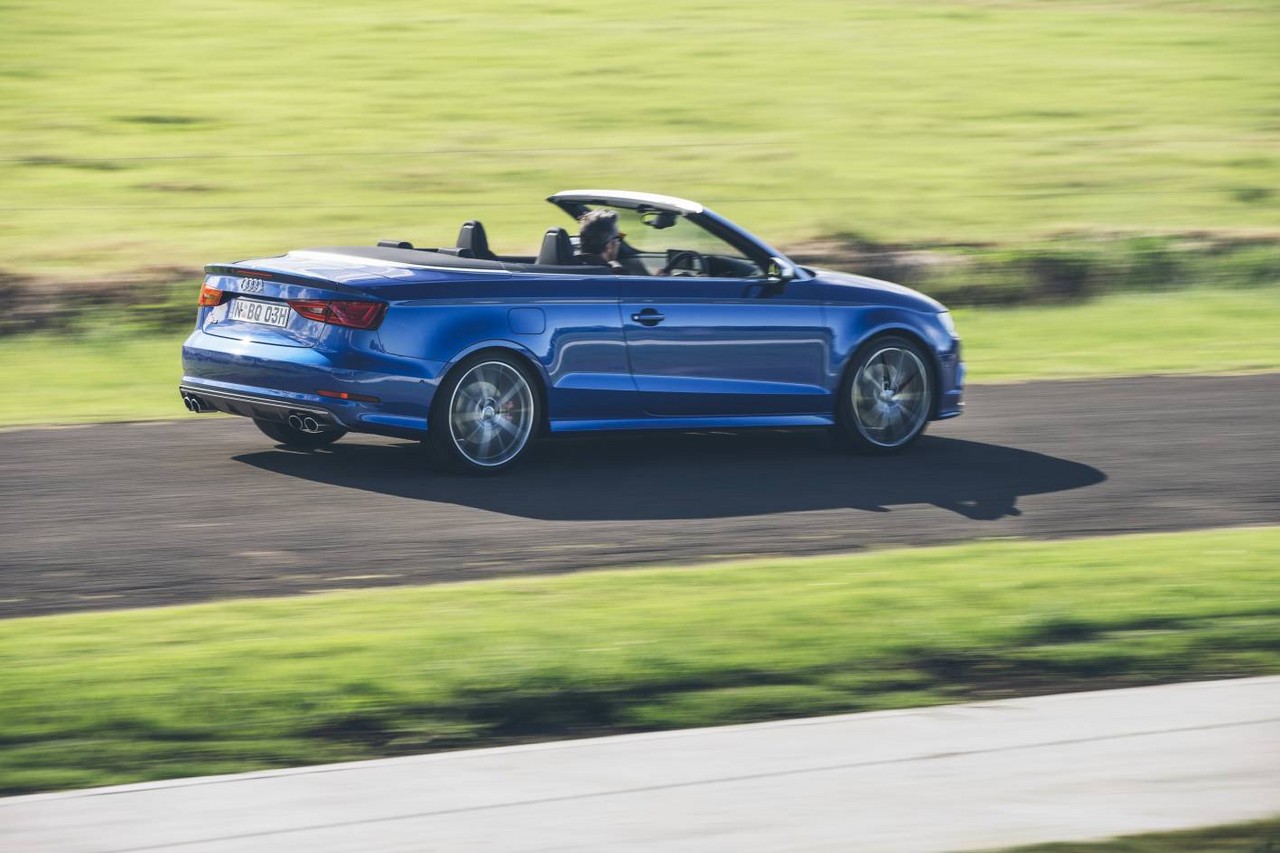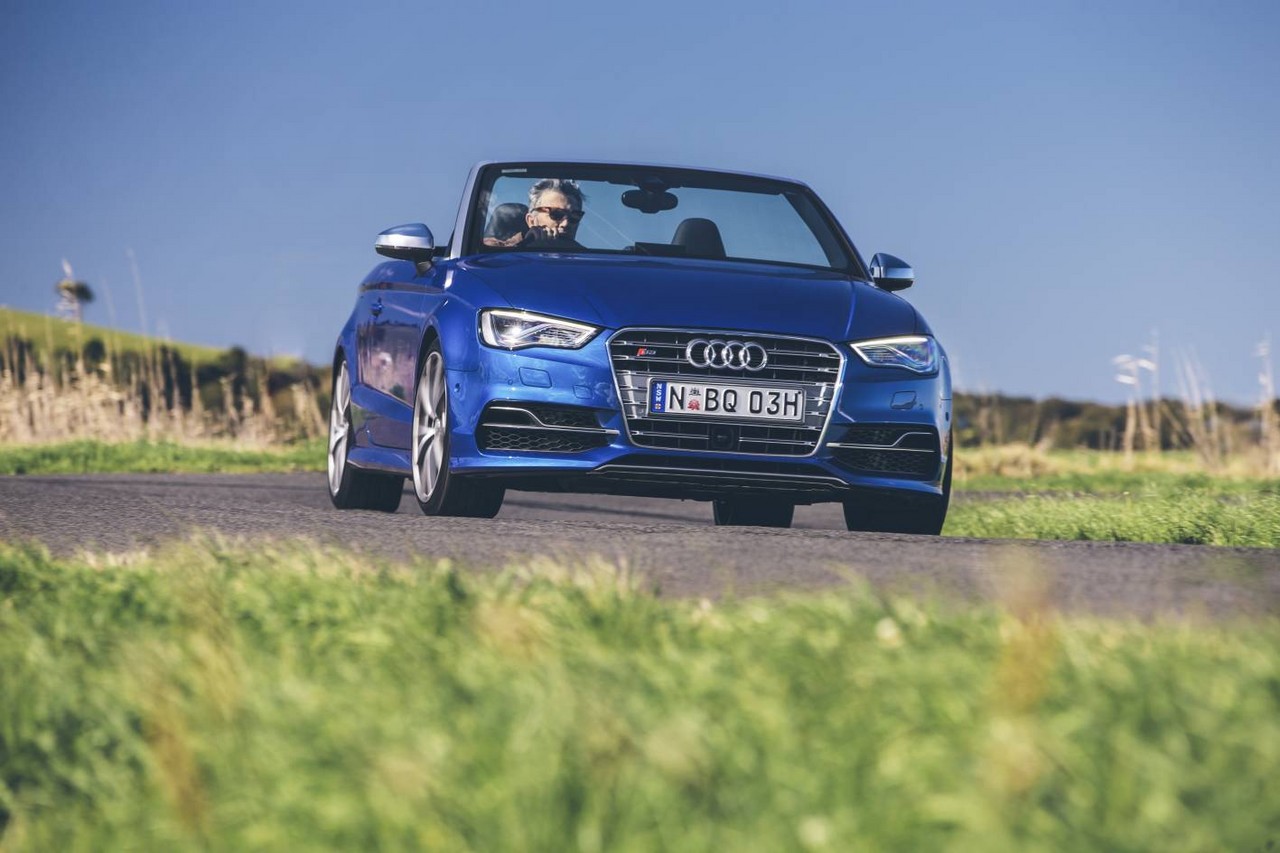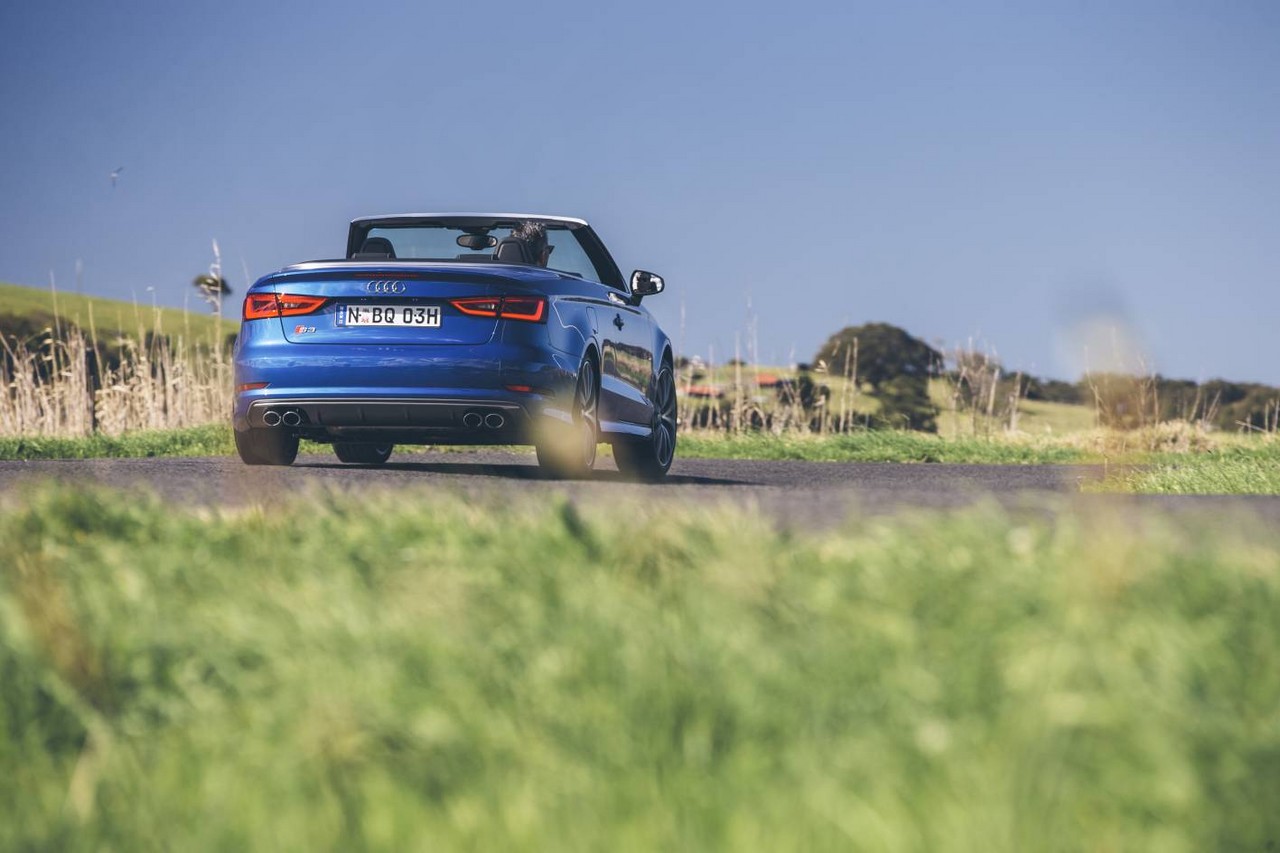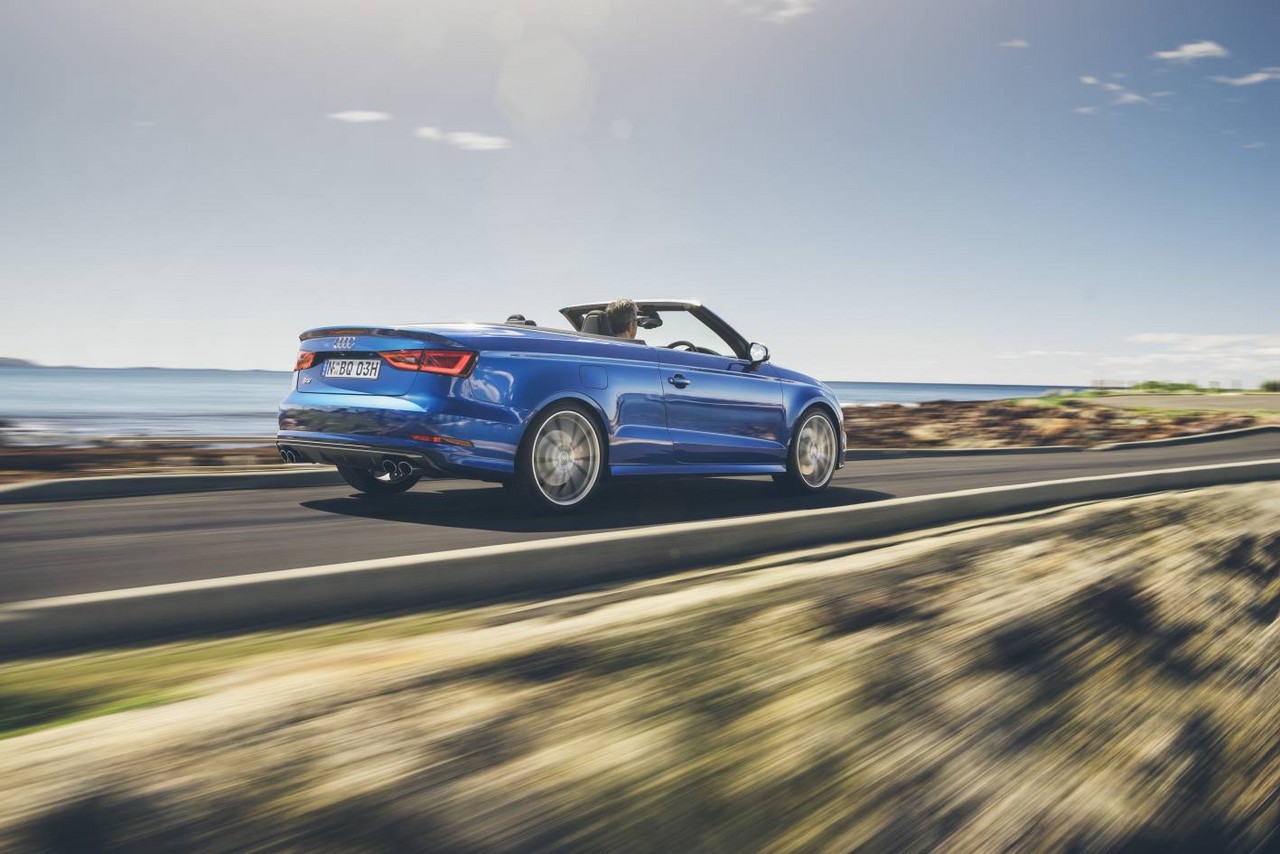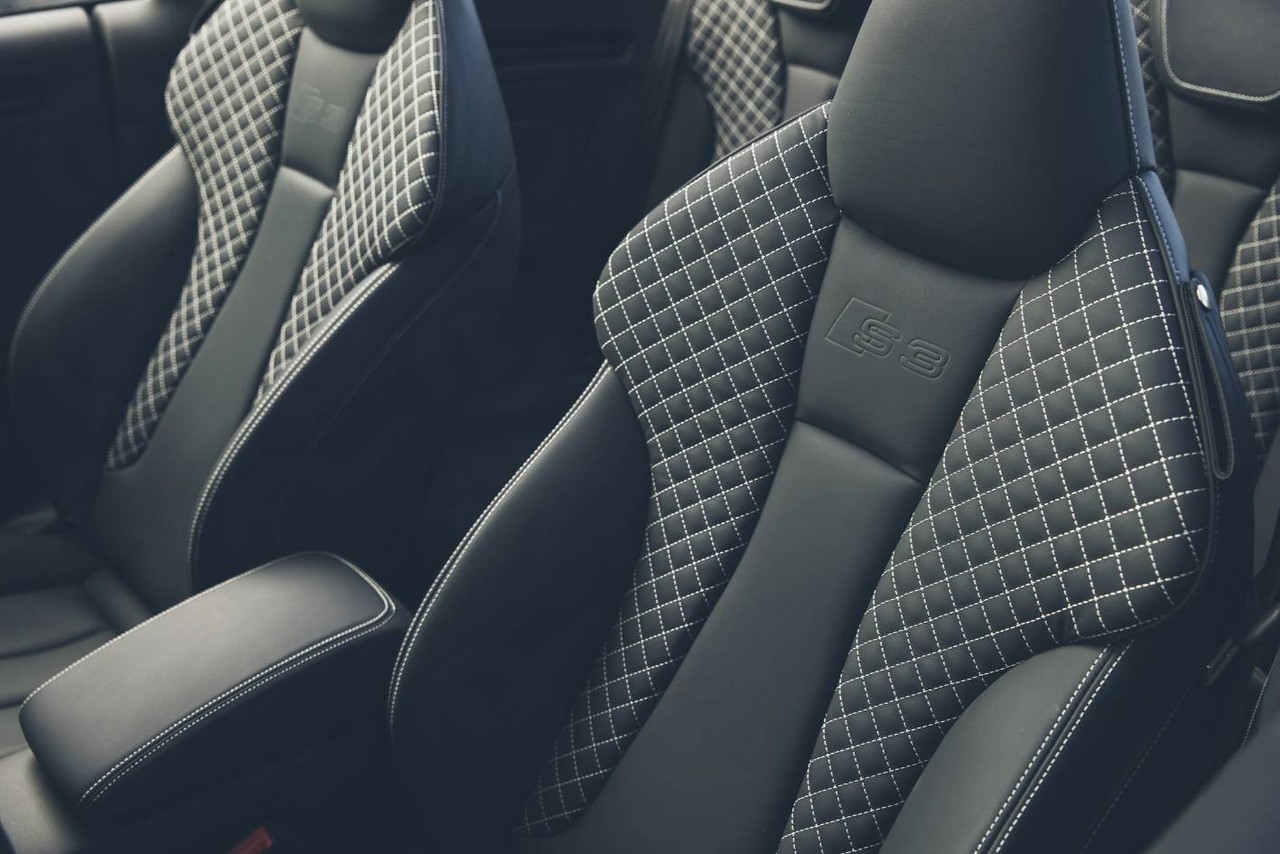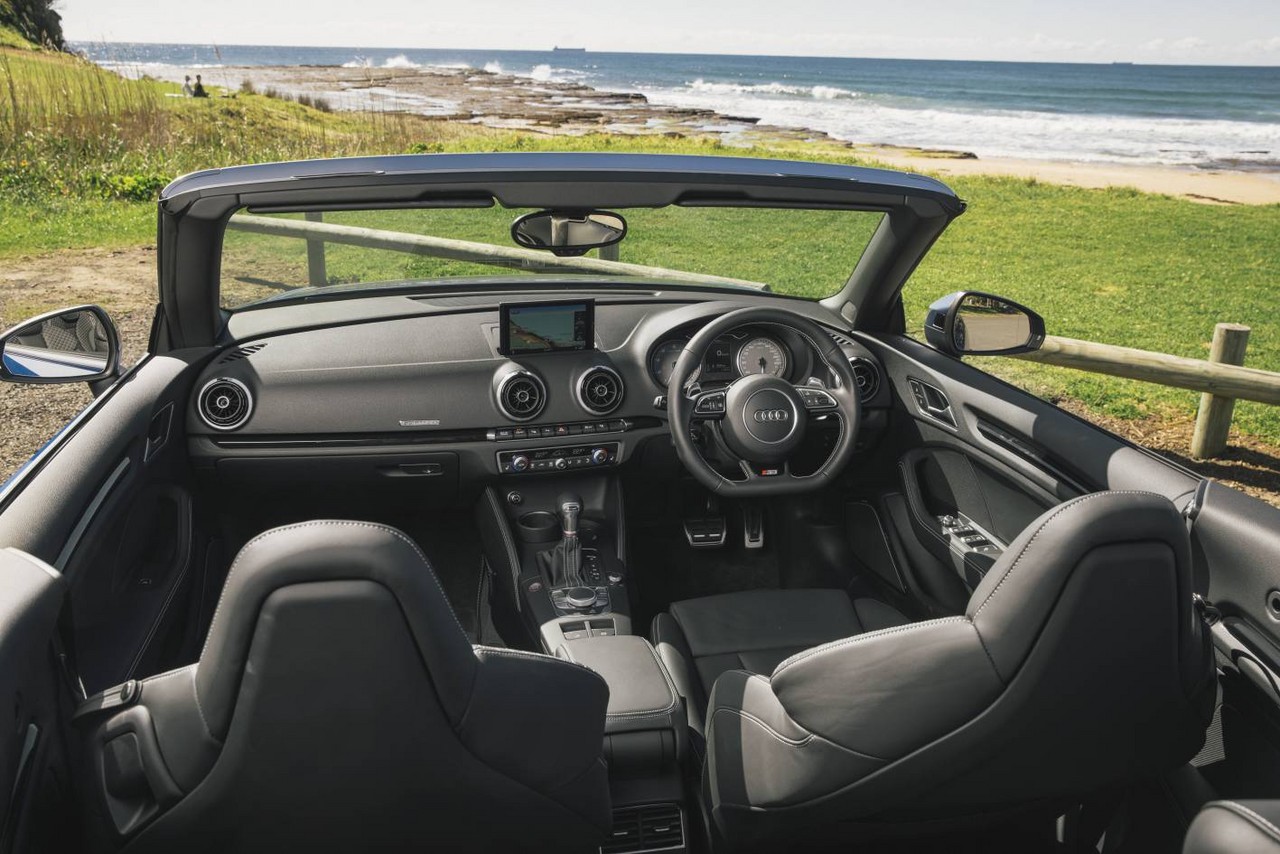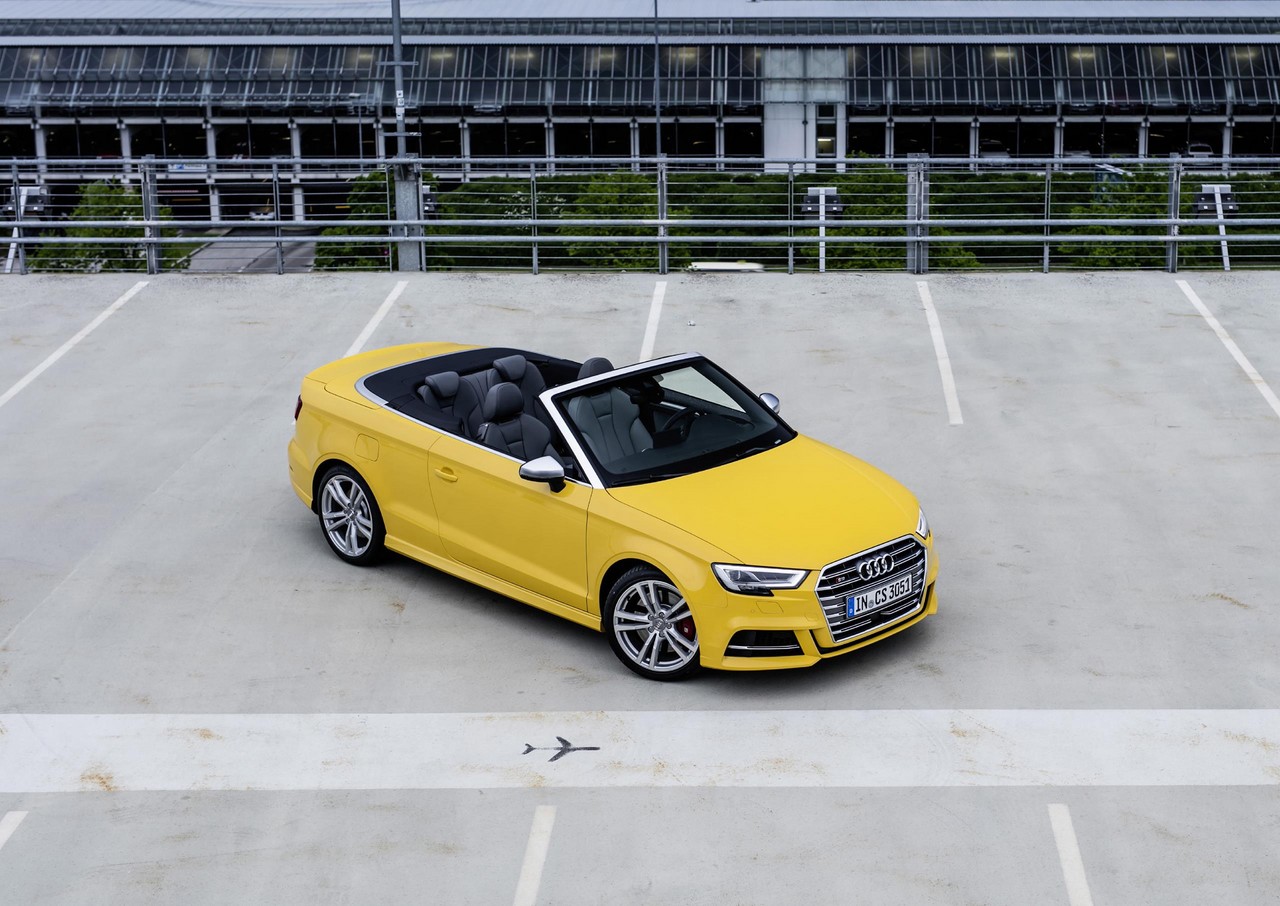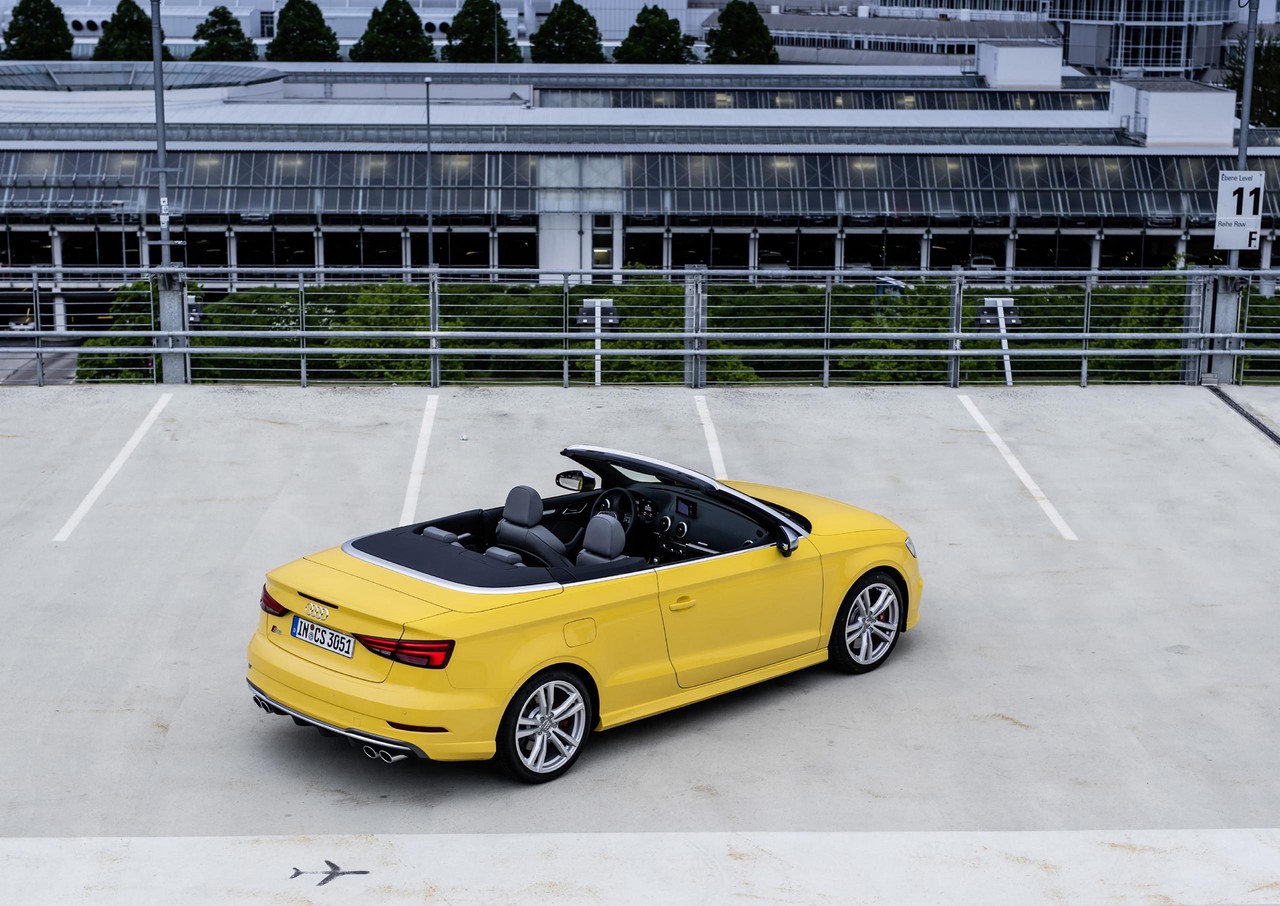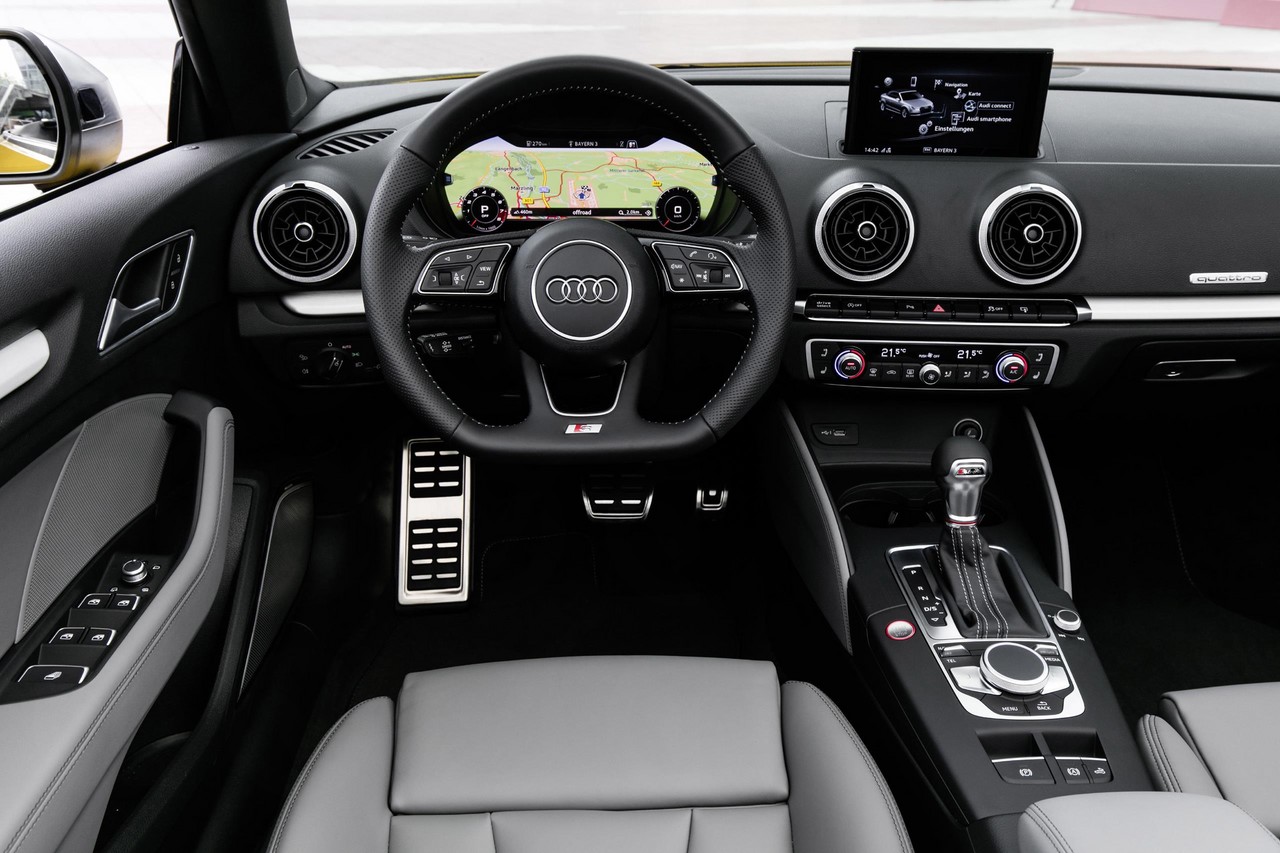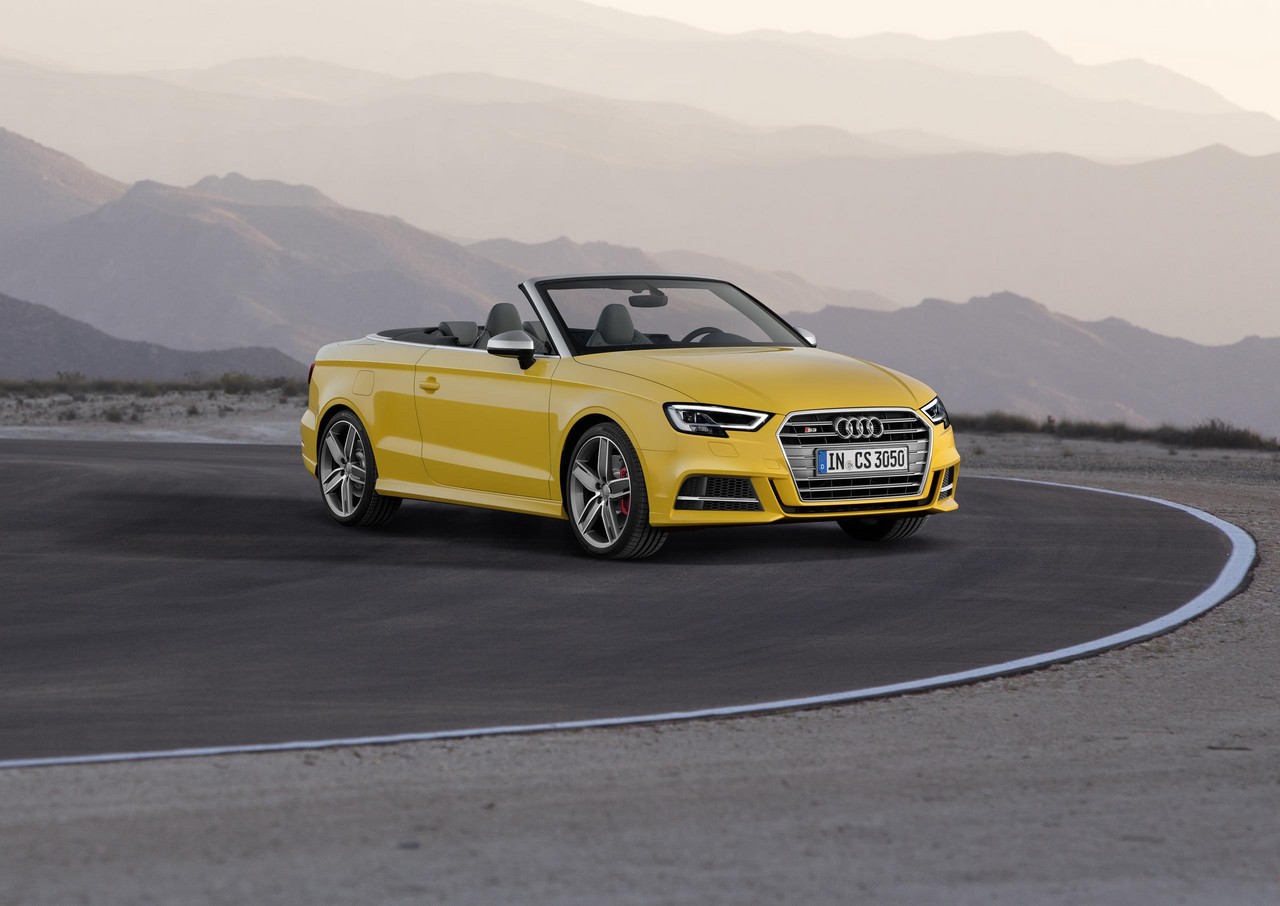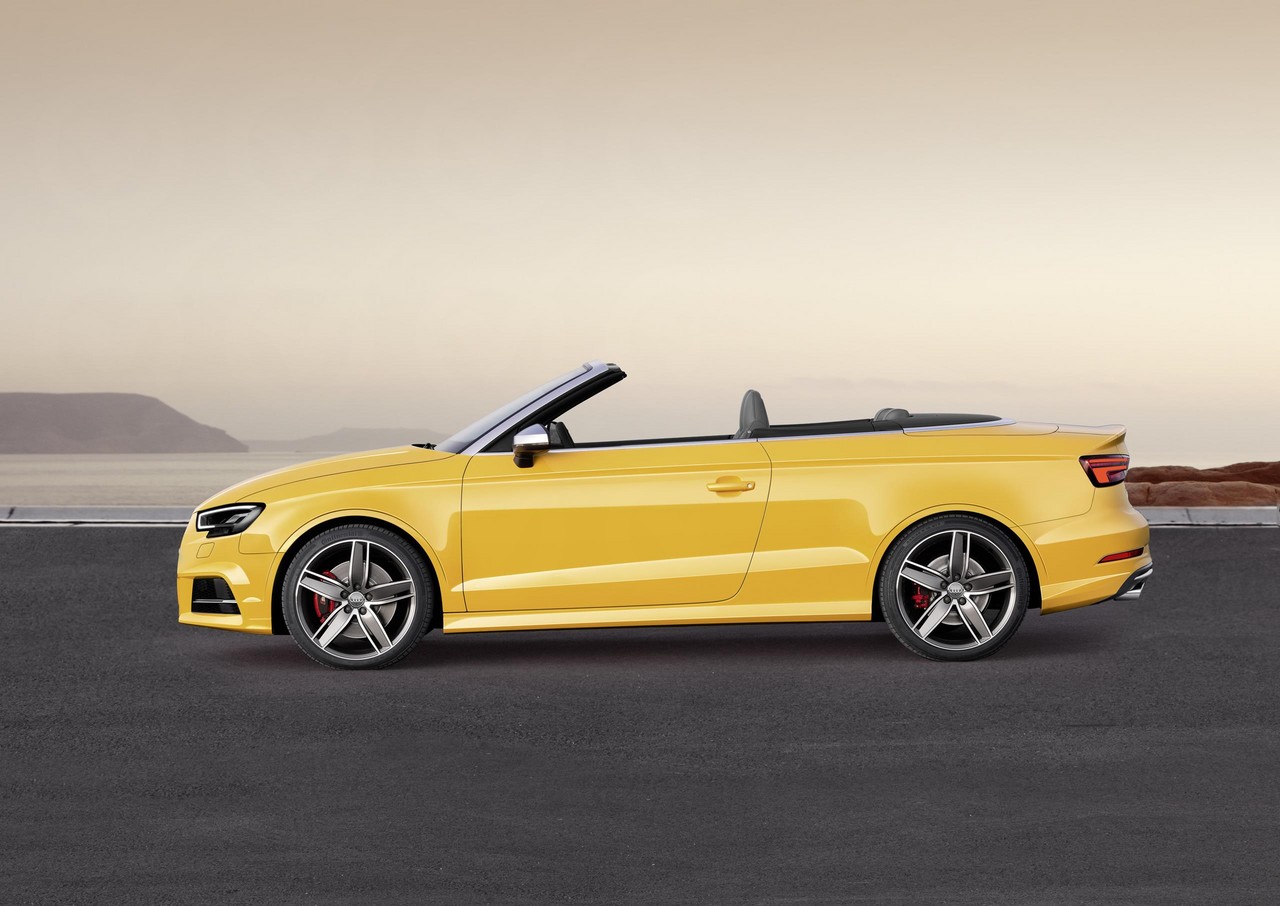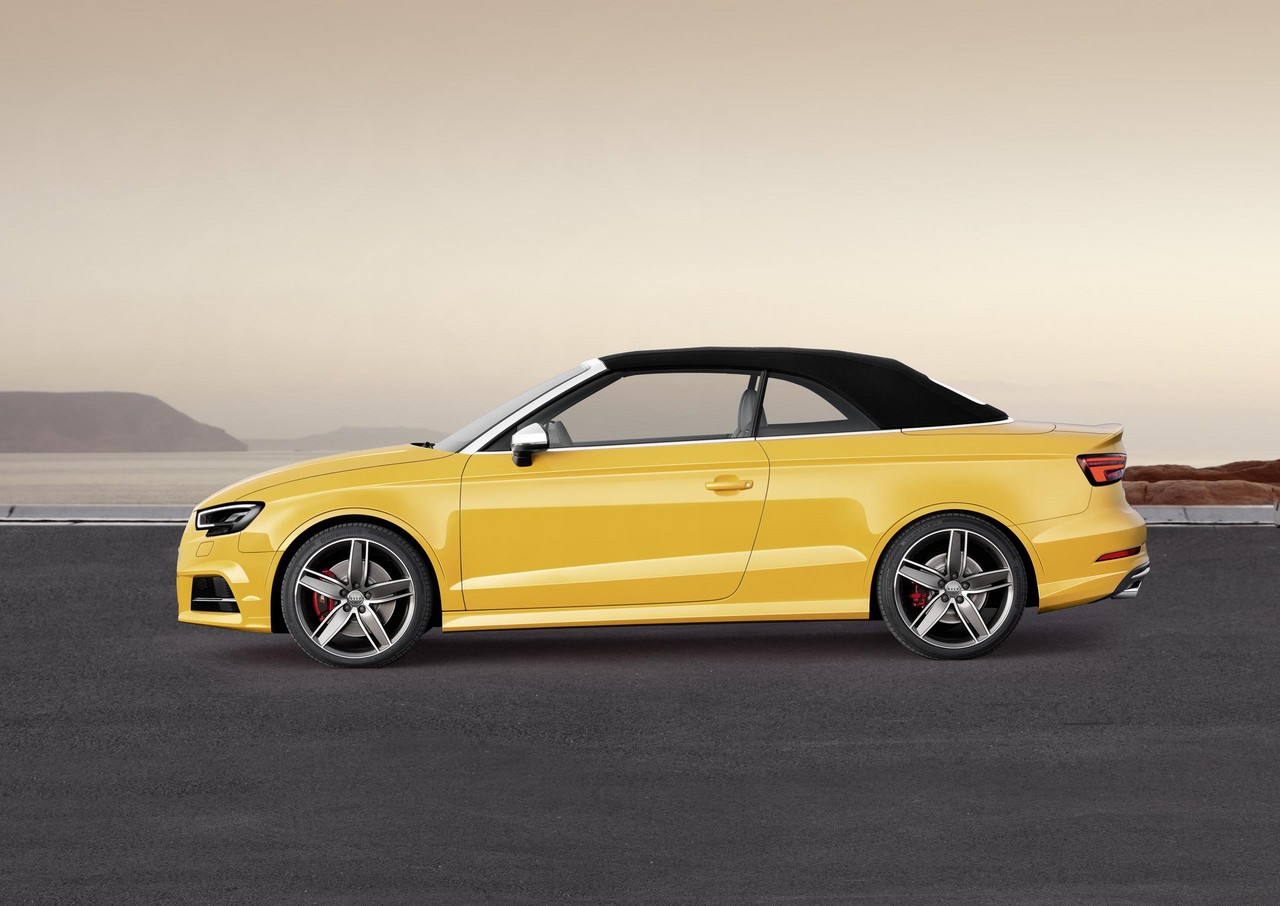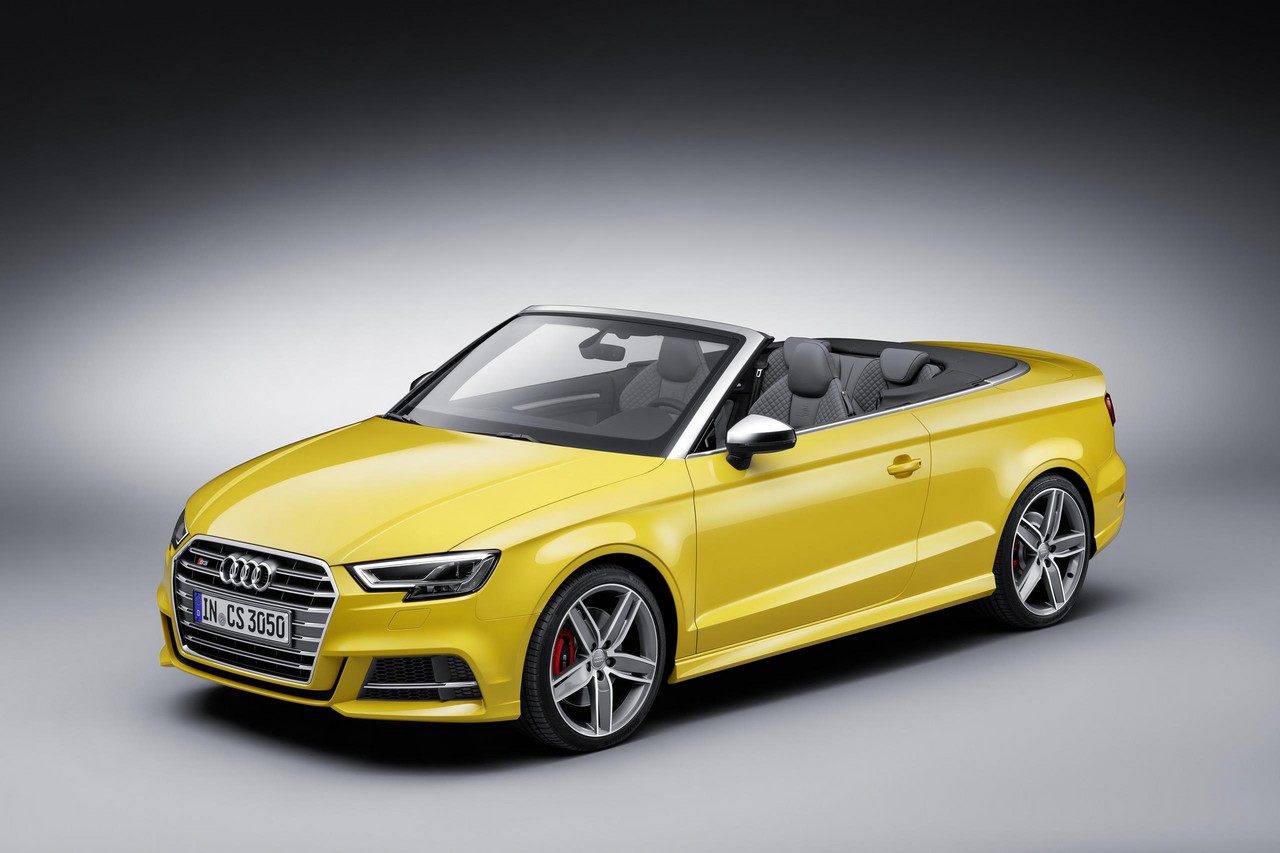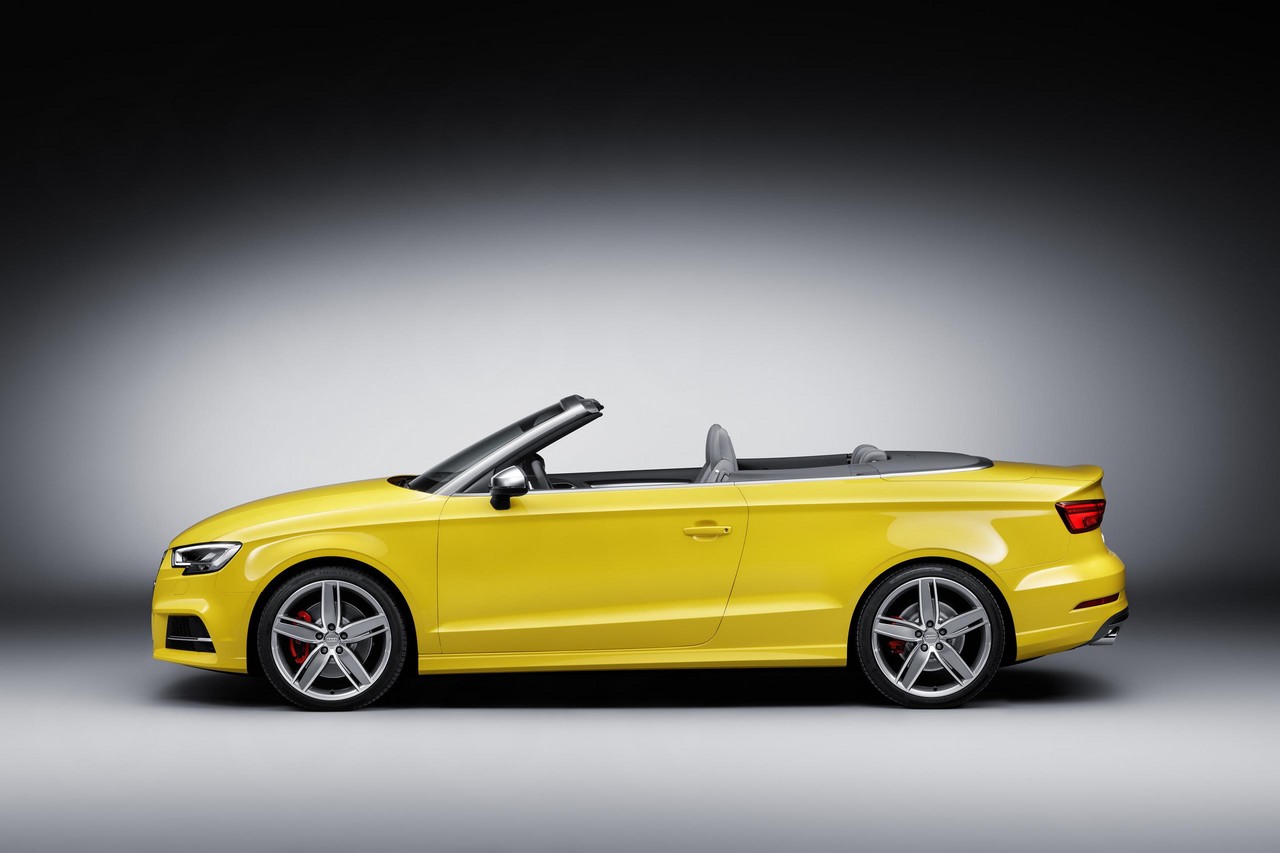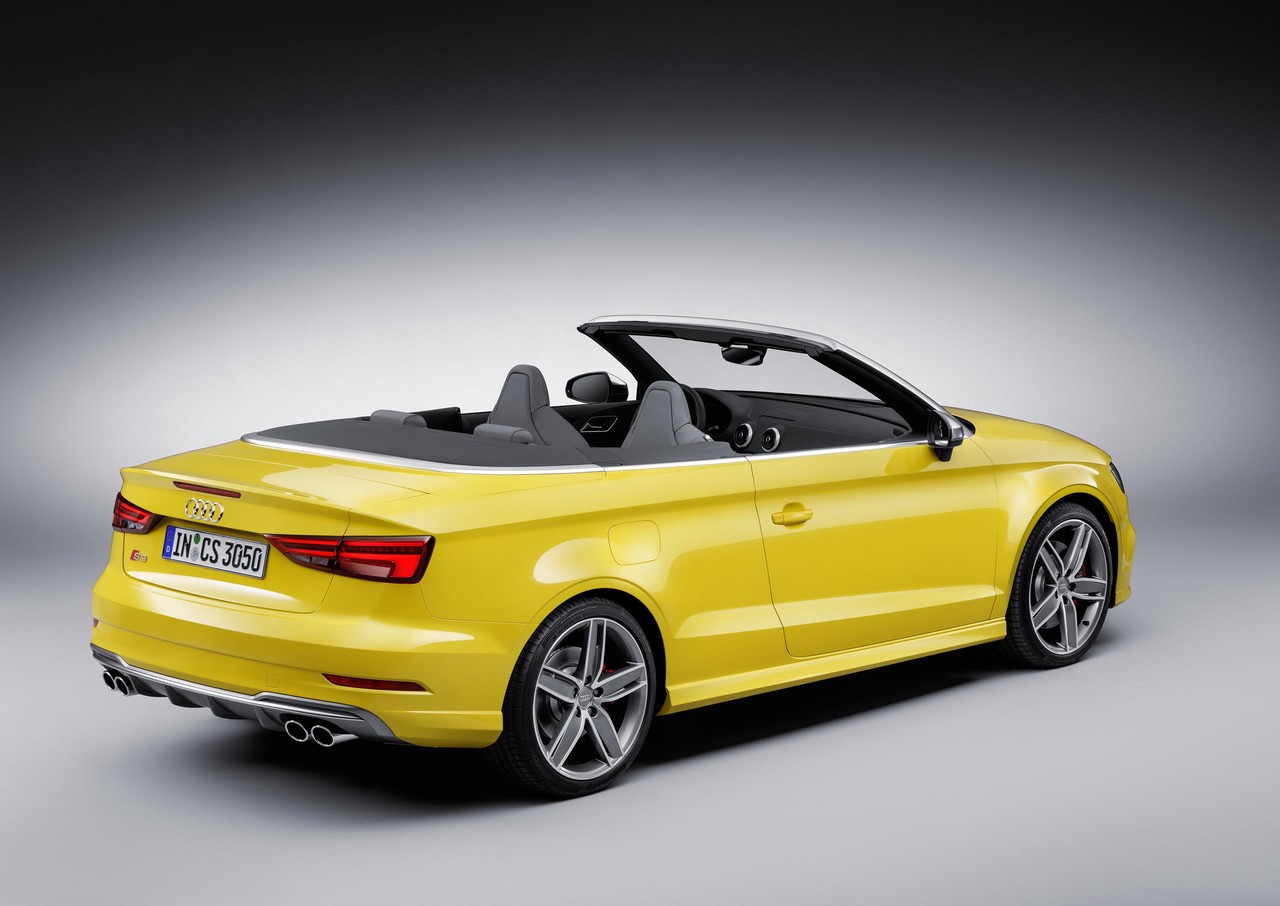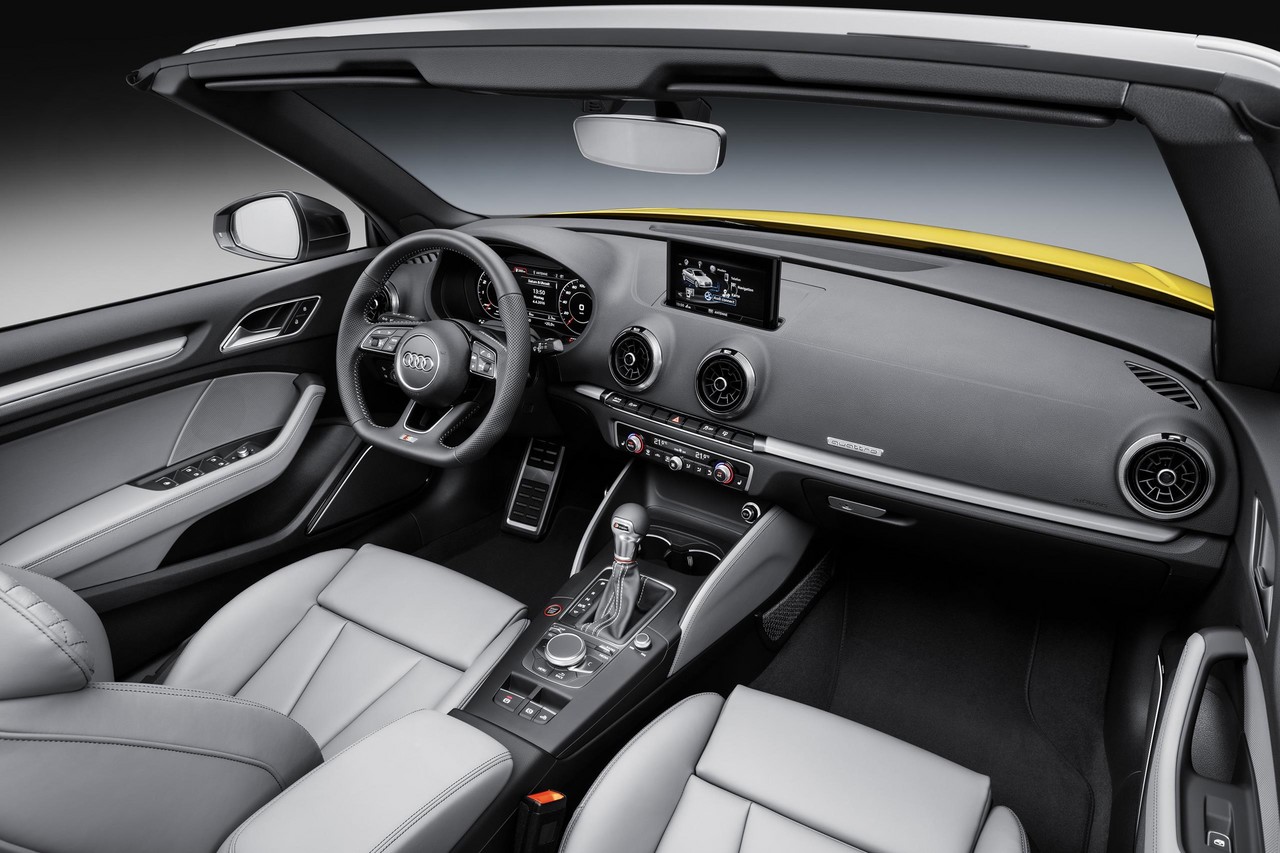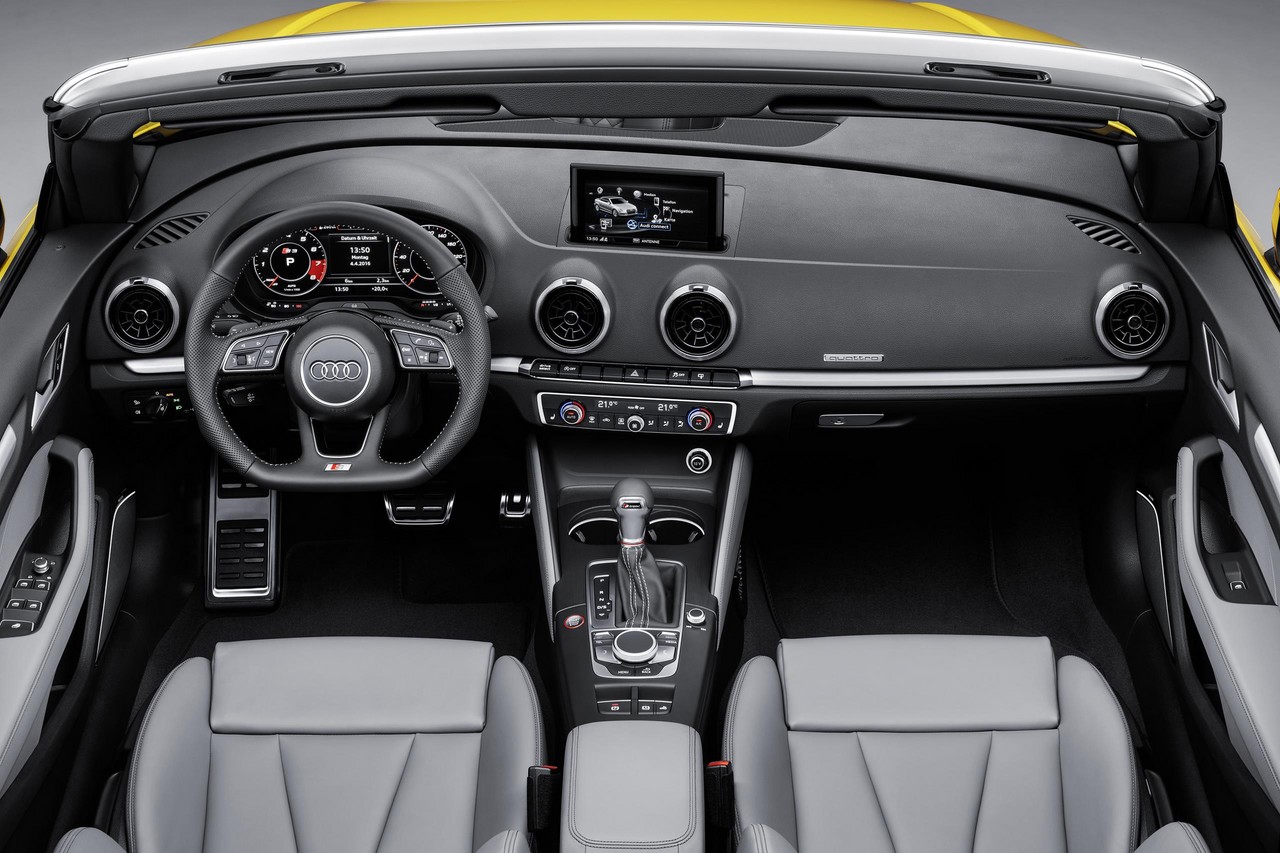
- High standard of interior fit and finish
- Body feels solid and rigid
- Well-insulated roof makes for quiet cabin
- Turbo failure for pre-October 2014 Audi S3 Cabriolet
- Lacks agility for an Audi ‘S’
- Cramped rear seats
- Limited boot space with roof down
Review: Audi 8V7.I S3 Cabriolet (2014-16)
Overview
Released in Australia in October 2014, the Audi 8V7 S3 Cabriolet was a two-door, four-seat convertible. Manufactured in Gyor, Hungary, the all-wheel drive Audi S3 Cabriolet was powered by a 2.0-litre turbocharged petrol engine that was mated to a six-speed double clutch transmission (Audi’s ‘S-Tronic’).
CJXB engine
While the European Audi S3 was powered by Audi’s 221 kW CJXC engine, the Australian-delivered S3 was powered by the CJXB engine which had a lower peak output (206 kW or 210 kW). Attributes of the CJXB and CJXC engines included a grey cast iron block, a forged steel crankshaft which was induction hardened and had four counterweights, an aluminium-silicon alloy cylinder head, double overhead camshafts driven by gear chains, four valves per cylinder actuated by roller cam followers with needle bearings, variable intake and exhaust valve timing, variable exhaust valve lift, an IHI turbocharger which provided peak boost pressure of 1.2 bar (17.4 psi), direct and indirect fuel injection, and a compression ratio of 9.3:1.
The 8V7 S3 Cabriolet could accelerate from rest to 100 km/h in 5.5 seconds.
| Engine | Trans. | Peak power | Peak torque | |
|---|---|---|---|---|
| S3 Cabriolet | 2.0-litre CJXB turbo petrol I4 | 6sp DCT | 210 kW at 5300-6200 rpm | 380 Nm at 1800-5200 rpm |
quattro all-wheel drive
The Audi 8V7 S3 Cabriolet had a fifth-generation Haldex all-wheel drive system which consisted of an electronically controlled and hydraulically actuated multi-plate clutch that was located in front of the rear axle differential (at the end of the prop shaft). Under low loads or when coasting, the rear axle was decoupled to minimise fuel consumption such that the S3 Cabriolet was front-wheel drive only. If there was a loss of front-wheel traction, or such a loss was anticipated by on-board sensors, the clutch would engage to force the plates together and transfer torque to the rear axle ‘in just a few milliseconds’ for a 50:50 front:rear torque split.
Dimensions
The Audi 8V7 S3 Cabriolet was 4434 mm long, 1793 mm wide (excluding mirrors), 1388 mm tall and had a 2596 mm long wheelbase. Cargo capacity for the S3 Cabriolet with its roof in position was 285 litres, though this decreased to 245 litres when the roof was retracted.
Steering and suspension
The 8V7 S3 Cabriolet had electric power-assisted steering, MacPherson strut front suspension and independent, four-link rear suspension.
Safety equipment
Standard safety equipment for the Audi 8V7 S3 Cabriolet included dual front airbags, a driver’s knee airbag, front seat-mounted side airbags, ABS, electronic brake force distribution, brake assist, electronic stability control, traction control and fronts seatbelts with pre-tensioners and load limiters.
Optional assistance package
As an extra-cost option, the S3 Cabriolet was available with an ‘Assistance package’ which included:
- Adaptive cruise control (ACC): radar-based cruise control which could maintain a preset distance from the car ahead. For models with the S-Tronic transmissions, ACC included a ‘stop & go’ function for stop-start traffic;
- Side assist: a blind spot monitoring system which monitored lane changes via a rear-facing radar;
- Active lane assist: helped drivers remain in their lane by making slight steering corrections via the electromechanical steering if necessary; and,
- Pre-sense basic: if the vehicle lost traction, the S3 Cabriolet would prepare for an accident by tensioning the front seatbelts and closing the windows (and sunroof if fitted); and,
- High-beam assist: adjusted the output of the xenon headlights to avoid dazzling oncoming traffic.
Brakes
The Audi 8V7 S3 Cabriolet had 340 mm by 30 mm ventilated front disc brakes and 310 mm by 22 mm ventilated rear disc brakes.
Features: Audi 8V7 S3 Cabriolet
Standard features for the Audi S3 Cabriolet included 18-inch alloy wheels with 225/40 R18 tyres, a 180 watt Audi sound system with ten speakers (including subwoofer) and a six-channel amplifier, Audi’s MMI navigation plus system with a seven-inch colour touchscreen, DVD player, two SDHC memory card readers, 20GB HDD, Bluetooth mobile phone connectivity and voice recognition, dual-zone climate control air conditioning, power adjustable and heated front seats, fine Nappa leather upholstery, cruise control, xenon headlights, daytime LED running lights, front and rear parking sensors, a reversing camera, automatic headlights, rain-sensing wipers, Bluetooth connectivity, a leather-wrapped steering wheel with gearshift paddles, remote central locking with proximity key, power windows and mirrors, tilt and telescopic steering column adjustment, tyre pressure monitoring, an auto-dimming rear view mirror, trip computer, alarm and immobiliser.
S Performance Pack
The Audi S3 Cabriolet was available with an optional S Performance Pack which included a 705 watt Bang & Olufsen sound system with fourteen speakers and a fifteen channel amplifier, LED headlights, diamond-stitch leather seat trim and red-painted brake calipers. The S Performance Pack also included ‘Magnetic Ride Control’ which could vary damping resistance by applying an electric current to the magnetorheological fluid within the dampers.
Related links
- Specifications and Equipment: Audi 8V7 S3 Cabriolet (October 2014)
- Technical Specifications: Audi 8V7 S3 Cabriolet (October 2014)
- Press Kit: Audi 8V7 S3 Cabriolet (October 2014)
Review: Audi 8V7.II S3 Cabriolet (2016-20)
Overview
Commencing production in May 2016 and officially released in Australia in November 2016, the Audi 8V7 Series II (8V7.II) S3 Cabriolet introduced cosmetic updates and autonomous emergency braking (AEB) as standard. For the 8V7.II S3 Cabriolet, unique calibrations were introduced for the electronic stability control and multi-plate clutch all-wheel drive system, with the latter providing ‘more frequent and pronounced torque distribution to the rear axle.’
Visually, the Audi 8V7.II S3 Cabriolet could be identified by its wider single-frame grille with which had sharper contours, flatter headlights (bi-xenon units as standard) with jagged bottom edges and new tail-lights. Inside, there were revised air conditioning vents, while the ‘Audi virtual cockpit’ – which replaced the analogue instrument dials with a 12.3-inch TFT screen – was available as an extra-cost option as part of the Technik package.
While the engines of European-delivered S3 Cabriolet vehicles produced peak outputs of 228 kW at 5500-6500 rpm and 400 Nm at 2000-5400 rpm, outputs were lower for Australian-delivered vehicles.
| Engine | Trans. | Peak power | Peak torque | |
|---|---|---|---|---|
| S3 Cabriolet | 2.0-litre turbo petrol I4 | 6sp DCT | 213 kW at 5400-6500 rpm | 380 Nm at 1850-5300 rpm |
Safety equipment
For the Audi 8V7.II S3 Cabriolet, standard safety equipment was extended to include –
- Audi pre-sense city with Autonomous Emergency Braking (AEB) and pedestrian detection: operating at speeds up to 85 km/h, Audi pre sense city used a windscreen-mounted front camera to scan the road for other vehicles and pedestrians. If there was a risk of a collision, the driver would receive a series of warnings and, if the driver failed to respond, full braking force would be applied autonomously. At initial speeds of up to 40 km/h, collisions can be prevented; at higher speeds (up to 85 km/h), the severity of the collision would be reduced;
- Audi pre sense basic: in the event that a collision was anticipated, pre sense basic initiated occupant protection measures such as electric tensioning of the seatbelts and closing of the windows and sunroof (where fitted);
- Audi side assist: operating at speeds above 15 km/h, Audi side assist used the two rear radar sensors to monitor traffic up to 70 metres behind the Audi S3 Cabriolet. If another vehicle approached quickly or was in the driver’s blind spot, a warning LED in the housing of the appropriate door mirror would illuminate. If the driver activated the indicator to change lanes, the LED would blink rapidly to warn the driver; and,
- Attention assist: monitored driver behaviour for signs of inattentiveness and would provide a warning tone and visual signal if detected.
Assistance package
As an extra-cost option, the Audi 8V7.II S3 Cabriolet could be specified with an ‘Assistance package’ which included –
- Adaptive Cruise Control (ACC): using two front radar sensors and the camera, ACC could maintain a specified distance – from five distances – between the S3 Cabriolet and the vehicle ahead. Furthermore, ‘Audi drive select’ could be used to adjust the rate of acceleration and other control dynamics;
- Stop&Go function: an extension of the, ‘Stop&Go’ operated at speeds of 60 km/h to apply the brakes and bring the vehicle to rest. Once traffic began moving, the Audi S3 Cabriolet would automatically accelerate;
- Traffic-jam assist: an extension of the ACC, traffic-jam assist function could take control of steering operations at speeds up to 65 km/h on ‘well-developed roads when traffic is congested.’ In doing so, traffic-jam assist used the lane markings and other vehicles on the road for orientation. When the traffic-jam assist function reached its limits – for example, when traffic is sparse or there is a sharp corner ahead – the driver had to take over steering. Hence, the system provided warnings at different levels;
- Audi pre-sense front: scanned the road for vehicles when travelling at speeds up to 200 km/h and for pedestrians when travelling at speeds of up to 65 km/h. If there was a risk of collision, the driver would be warned and partial braking would be initiated automatically. If the collision risk persisted, full braking could be initiated (i.e. autonomous emergency braking or AEB).
- High beam assist: automatically switched between low and high beam headlights for improved visibility, using a sensor to determine when it was safe to do so (i.e. without dazzling other drivers);
- Audi active lane assist: operating at speeds of 65 km/h and above, Audi active lane assist used the front camera to recognise lane markings. As the vehicle approached a lane marking without the turn signal having been activated, the system provided a slight steering intervention to direct the vehicle back into its lane. Through the MMI system, the driver could select whether this intervention occurred at an early stage (in which case the vehicle was steered to the centre of its lane) or only shortly before crossing the line. The steering wheel could also vibrate as a warning signal if selected;
- Cross traffic assist rear: when reversing at low speeds, rear cross-traffic assist used the rear radar sensors to detect approaching traffic. If approaching traffic was detected which may cross the vehicle’s path, the driver received warnings (visual, acoustic and a brief, jolting application of the brakes); and,
- Hold assist: would automatically apply the brakes when the vehicle was stationary to prevent it from rolling as the driver moved their foot from the brake to the accelerator.
Features: Audi 8V7.II S3 Cabriolet
Compared to the 8V7.I S3 Cabriolet, standard features for the Audi 8V7.II S3 Cabriolet were extended to include a digital radio tuner (DAB+), the ‘Audi smartphone interface’ which provided Apple CarPlay and Android Auto smartphone integration via the USB port, LED headlights and ‘park assist’ which provided automated steering for parallel or perpendicular parking manoeuvres while the driver controlled vehicle speed.
Matrix LED headlights
As an extra-cost option, the Audi 8V7.II S3 Cabriolet could be specified with ‘Matrix LED’ headlights which used fifteen LEDs each produce a high beam that radiated from three reflectors. Using information from the forward-facing camera, their control module could turn them on or off individually, or dim them in 64 stages.
Specifications
Related links
